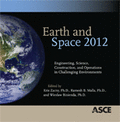Cratering of a Lunar Soil Simulant, JSC-1A, by a Turbulent Subsonic Jet
Publication: Earth and Space 2012: Engineering, Science, Construction, and Operations in Challenging Environments
Abstract
Impinging rocket plumes from spacecraft interact with the lunar regolith surface and release a high velocity particle-spray that is potentially hazardous to surrounding surface structures and surface architecture. Experiments performed at NASA-KSC and the University of Florida provide data on the cratering of a particle bed composed of lunar soil simulant JSC-1A by a turbulent subsonic jet of gas. Cratering experiments were also performed on beach sand, which has a narrower particle size distribution than JSC-1A. JSC-1A contains a wide particle size distribution with a high number of fine particles (20% by volume less than 35 μm). JSC-1A is highly compressible and contains much rougher and more angular particles than beach sand. The differences in the particle properties between JSC-1A and beach sand leads to stark differences in the cratering of the two materials. The cratering of beach sand results in a dual crater shape consisting of a conical outer crater and a paraboloid inner crater. While the jet is impinging on the sand, the crater grows logarithmically with time and the outer crater cycles between the angle of repose and angle of failure as particles are ejected from the inner crater onto the outer crater. The JSC-1A crater is similar to a scour hole in shape, which grows deeper over time, with large chunks of material being eroded by the jet. The growth rate of the crater of JSC-1A is highly dependent on the bulk bed density of the JSC-1A. For the same jet velocity the cratering rate of a bed of JSC-1A with a higher bulk density (more compact) was slower than a bed with a lower bulk density (less compact). Even for a lower jet velocity, the less compact bed can crater faster than the more compact bed. The cratering of a sieved fraction of JSC-1A in the absence of fine particles is studied by sieving to a particle size range of 150 to 425 μm. The cratering of sieved JSC-1A is more similar to the cratering of beach sand than to unsieved JSC-1A indicating that the presence of fine particles in unsieved JSC-1A is the cause for its atypical cratering behavior.
Get full access to this chapter
View all available purchase options and get full access to this chapter.
Information & Authors
Information
Published In
Copyright
© 2012 American Society of Civil Engineers.
History
Published online: Jul 11, 2012
Authors
Metrics & Citations
Metrics
Citations
Download citation
If you have the appropriate software installed, you can download article citation data to the citation manager of your choice. Simply select your manager software from the list below and click Download.
